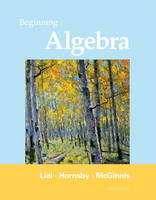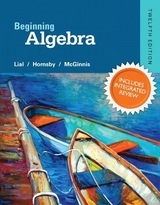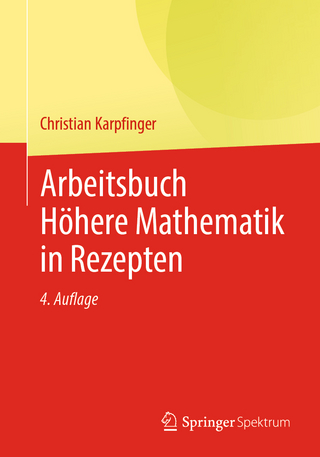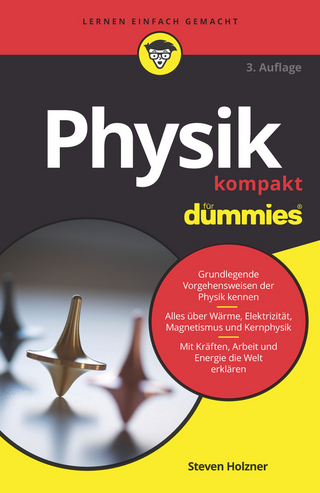
Beginning Algebra
Pearson (Verlag)
978-0-321-67348-0 (ISBN)
- Titel erscheint in neuer Auflage
- Artikel merken
¿
With this revision, the Lial team has further refined the presentation and exercises throughout the text. They offer several exciting new resources for students that will provide extra help when needed, regardless of the learning environment (classroom, lab, hybrid, online, etc)–new study skills activities in the text, an expanded video program available in MyMathLab and on the Video Resources on DVD, and more!
¿
This ISBN is for the textbook only. MyMathLab access kit, Video Resources on DVD, and other resources are available separately.
Marge Lial was always interested in math; it was her favorite subject in the first grade! Marge's intense desire to educate both her students and herself has inspired the writing of numerous best-selling textbooks. Marge, who received Bachelor's and Master's degrees from California State University at Sacramento, is affiliated with American River College. Marge is an avid reader and traveler. Her travel experiences often find their way into her books as applications, exercise sets, and feature sets. She is particularly interested in archeology. Trips to various digs and ruin sites have produced some fascinating problems for her textbooks involving such topics as the building of Mayan pyramids and the acoustics of ancient ball courts in the Yucatan. When John Hornsby enrolled as an undergraduate at Louisiana State University, he was uncertain whether he wanted to study mathematics education or journalism. His ultimate decision was to become a teacher, but after twenty-five years of teaching at the high school and university levels and fifteen years of writing mathematics textbooks, both of his goals have been realized. His love for both teaching and for mathematics is evident in his passion for working with students and fellow teachers as well. His specific professional interests are recreational mathematics, mathematics history, and incorporating graphing calculators into the curriculum. John's personal life is busy as he devotes time to his family (wife Gwen, and sons Chris, Jack, and Josh), and has been an avid baseball fan all of his life. John's other hobbies include numismatics (the study of coins) and record collecting. He loves the music of the 1960s and has an extensive collection of the recorded works of Frankie Valli and the Four Seasons. A native Midwesterner,Terry McGinnis received her Bachelor’s of Science in Elementary Education with a concentration in Mathematics from Iowa State University. She has taught elementary and middle school mathematics, and developed and implemented the curriculum used with her students. Terry has been involved in college mathematics publishing for over 20 years, working with a variety of authors on textbooks in both developmental mathematics and precalculus. After working behind the scenes on many of the Lial/Hornsby textbooks and supplements for over 10 years, Terry joined Margaret Lial and John Hornsby in 2002 as coauthor of their developmental mathematics series that includes Introductory Algebra, Intermediate Algebra, and Introductory and Intermediate Algebra. When not working, Terry enjoys spinning at a local health club, walking, and reading fiction. She is the devoted mother of two sons, Andrew and Tyler.
Note: each chapter concludes with a Chapter Summary, Chapter Review Exercises, Chapter Test, and after Chapter 1, a set of Cumulative Review Exercises.
Chapter 1: The Real Number System
1.1 Fractions
1.2 Exponents, Order of Operations, and Inequality
Study Skills: Taking Lecture Notes
1.3 Variables, Expressions, and Equations
1.4 Real Numbers and the Number Line
Study Skills: Tackling Your Homework
1.5 Adding and Subtracting Real Numbers
Study Skills: Using Study Cards
1.6 Multiplying and Dividing Real Numbers
Summary Exercises on Operations with Real Numbers
1.7 Properties of Real Numbers
1.8 Simplifying Expressions
Study Skills: Reviewing a Chapter
Chapter 2: Linear Equations and Inequalities in One Variable
2.1 The Addition Property of Equality
2.2 The Multiplication Property of Equality
2.3 More on Solving Linear Equations
Summary Exercises on Solving Linear Equations
Study Skills: Using Study Cards Revisited
2.4 An Introduction to Applications of Linear Equations
2.5 Formulas and Additional Applications from Geometry
2.6 Ratio, Proportion, and Percent
2.7 Further Applications of Linear Equations
2.8 Solving Linear Inequalities
Study Skills: Taking Math Tests
Chapter 3: Linear Equations and Inequalities in Two Variables; Functions
3.1 Linear Equations in Two Variables; The Rectangular Coordinate System
Study Skills: Managing Your Time
3.2 Graphing Linear Equations in Two Variables
3.3 The Slope of a Line
3.4 Writing and Graphing Equations of Lines
Summary Exercises on Linear Equations and Graphs
3.5 Graphing Linear Inequalities in Two Variables
3.6 Introduction to Functions
Study Skills: Analyzing Your Test Results
Chapter 4: Systems of Linear Equations and Inequalities
4.1 Solving Systems of Linear Equations by Graphing
4.2 Solving Systems of Linear Equations by Substitution
4.3 Solving Systems of Linear Equations by Elimination
Summary Exercises on Solving Systems of Linear Equations
4.4 Applications of Linear Systems
4.5 Solving Systems of Linear Inequalities
Chapter 5: Exponents and Polynomials
5.1 The Product Rule and Power Rules for Exponents
5.2 Integer Exponents and the Quotient Rule
Summary Exercises on the Rules for Exponents
5.3 An Application of Exponents: Scientific Notation
5.4 Adding and Subtracting Polynomials; Graphing Simple Polynomials
5.5 Multiplying Polynomials
5.6 Special Products
5.7 Dividing Polynomials
Chapter 6: Factoring and Applications
6.1 The Greatest Common Factor; Factoring by Grouping
6.2 Factoring Trinomials
6.3 More on Factoring Trinomials
6.4 Special Factoring Techniques
Summary Exercises on Factoring
6.5 Solving Quadratic Equations by Factoring
6.6 Applications of Quadratic Equations
Chapter 7: Rational Expressions and Applications
7.1 The Fundamental Property of Rational Expressions
7.2 Multiplying and Dividing Rational Expressions
7.3 Least Common Denominators
7.4 Adding and Subtracting Rational Expressions
7.5 Complex Fractions
7.6 Solving Equations with Rational Expressions
Summary Exercises on Rational Expressions and Equations
7.7 Applications of Rational Expressions
7.8 Variation
Study Skills: Preparing for Your Math Final Exam
Chapter 8: Roots and Radicals
8.1 Evaluating Roots
8.2 Multiplying, Dividing, and Simplifying Radicals
8.3 Adding and Subtracting Radicals
8.4 Rationalizing the Denominator
8.5 More Simplifying and Operations with Radicals
Summary Exercises on Operations with Radicals
8.6 Solving Equations with Radicals
8.7 Using Rational Numbers as Exponents
Chapter 9: Quadratic Equations
9.1 Solving Quadratic Equations by the Square Root Property
9.2 Solving Quadratic Equations by Completing the Square
9.3 Solving Quadratic Equations by the Quadratic Formula
Summary Exercises on Quadratic Equations
9.4 Complex Numbers
9.5 More on Graphing Quadratic Equations; Quadratic Functions
Appendix: Sets
| Erscheint lt. Verlag | 21.4.2011 |
|---|---|
| Sprache | englisch |
| Maße | 227 x 284 mm |
| Gewicht | 1450 g |
| Themenwelt | Mathematik / Informatik ► Mathematik ► Algebra |
| ISBN-10 | 0-321-67348-4 / 0321673484 |
| ISBN-13 | 978-0-321-67348-0 / 9780321673480 |
| Zustand | Neuware |
| Informationen gemäß Produktsicherheitsverordnung (GPSR) | |
| Haben Sie eine Frage zum Produkt? |
aus dem Bereich



